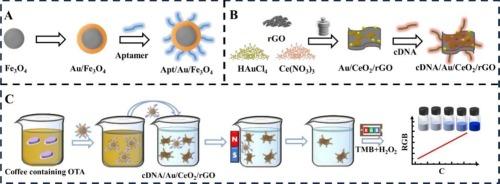智能手机辅助防污比色适体传感器用于咖啡中赭曲霉毒素A的超灵敏检测
IF 4.9
2区 化学
Q1 CHEMISTRY, ANALYTICAL
引用次数: 0
摘要
利用Au/ ce2 /rGO纳米杂化材料构建了智能手机辅助比色感应传感器,用于检测赭曲霉毒素A (OTA)。该传感器集成了适配体功能化Au/Fe3O4 (Apt/Au/Fe3O4)作为识别元件。互补链修饰的Au/CeO 2 /rGO (cDNA/Au/CeO 2 /rGO)作为纳米酶催化剂,将3,3 ',5,5 ' -四甲基联苯胺(TMB)氧化为蓝色的ox-TMB。检测机制依赖于OTA与cDNA/Au/CeO2/rGO对Apt/Au/Fe3O4的竞争性结合。OTA引入后,OTA优先与Apt/Au/Fe3O4结合。这些Apt/Au/Fe3O4被磁分离并引入到cDNA/Au/CeO2/rGO悬浮液中。未结合的Apt/Au/Fe3O4与cDNA/Au/CeO2/rGO相互作用。磁分离后,上清液中残余cDNA/Au/CeO2/rGO浓度与OTA浓度呈相关性。这种设计有效地消除了咖啡固有颜色的潜在干扰,显著提高了比色检测的准确性。检测限为27.3 pg mL−1。经酶联免疫吸附试验证实,该方法在咖啡中的回收率为102.1 ~ 117.4%。本文章由计算机程序翻译,如有差异,请以英文原文为准。

Smartphone-assisted antifouling colorimetric aptasensor for ultrasensitive ochratoxin A detection in coffee
A smartphone-assisted colorimetric aptasensor was constructed for the detection of ochratoxin A (OTA) utilizing Au/CeO₂/rGO nanohybrid. The sensor integrates aptamer-functionalized Au/Fe3O4 (Apt/Au/Fe3O4) as recognition elements. The complementary-chain-modified Au/CeO₂/rGO (cDNA/Au/CeO₂/rGO) act as nanozyme catalyst for signal amplification through the oxidation of 3,3′,5,5′-tetramethylbenzidine (TMB) to blue-colored ox-TMB. The detection mechanism relies on competitive binding between OTA and cDNA/Au/CeO2/rGO to Apt/Au/Fe3O4. Upon OTA introduction, OTA preferentially binds to Apt/Au/Fe3O4. These Apt/Au/Fe3O4 are magnetically separated and introduced into the cDNA/Au/CeO2/rGO suspension. Unbound Apt/Au/Fe3O4 interacts with cDNA/Au/CeO2/rGO. After magnetic separation, the residual cDNA/Au/CeO2/rGO concentration in supernatant exhibits a correlation with the OTA concentration. This design effectively eliminates potential interference from the intrinsic color of coffee, significantly improving the accuracy of colorimetric detection. The aptasensor demonstrated superior selectivity towards OTA with a detection limit of 27.3 pg mL−1. This specificity was validated against interference, with recovery rates of 102.1–117.4 % in coffee, as confirmed by ELISA.
求助全文
通过发布文献求助,成功后即可免费获取论文全文。
去求助
来源期刊

Microchemical Journal
化学-分析化学
CiteScore
8.70
自引率
8.30%
发文量
1131
审稿时长
1.9 months
期刊介绍:
The Microchemical Journal is a peer reviewed journal devoted to all aspects and phases of analytical chemistry and chemical analysis. The Microchemical Journal publishes articles which are at the forefront of modern analytical chemistry and cover innovations in the techniques to the finest possible limits. This includes fundamental aspects, instrumentation, new developments, innovative and novel methods and applications including environmental and clinical field.
Traditional classical analytical methods such as spectrophotometry and titrimetry as well as established instrumentation methods such as flame and graphite furnace atomic absorption spectrometry, gas chromatography, and modified glassy or carbon electrode electrochemical methods will be considered, provided they show significant improvements and novelty compared to the established methods.
 求助内容:
求助内容: 应助结果提醒方式:
应助结果提醒方式:


